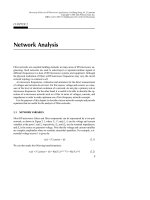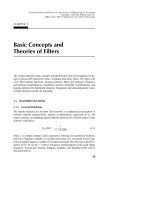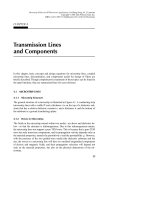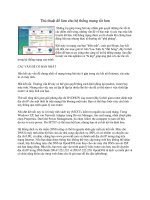Tài liệu Lò vi sóng RF và hệ thống không dây P4 ppt
Bạn đang xem bản rút gọn của tài liệu. Xem và tải ngay bản đầy đủ của tài liệu tại đây (482.77 KB, 38 trang )
CHAPTER FOUR
Various Components and Their
System Parameters
4.1 INTRODUCTION AND HISTORY
An RF and microwave system consists of many different components connected by
transmission lines. In general, the components are classified as passive components
and active (or solid-state) components. The passive components include resistors,
capacitors, inductors, connectors, transitions, transformers, tapers, tuners, matching
networks, couplers, hybrids, power dividers=combiners, baluns, resonators, filters,
multiplexers, isolators, circulators, delay lines, and antennas. The solid-state devices
include detectors, mixers, switches, phase shifters, modulators, oscillators, and
amplifiers. Strictly speaking, active components are devices that have negative
resistance capable of generating RF power from the DC biases. But a more general
definition includes all solid-state devices.
Historically, wires, waveguides, and tubes were commonly used before 1950.
After 1950, solid-state devices and integrated circuits began emerging. Today,
monolithic integrated circuits (or chips) are widely used for many commercial and
military systems. Figure 4.1 shows a brief history of microwave technologies. The
commonly used solid-state devices are MESFETs (metal–semiconductor field-effect
transistors), HEMTs (high-electron-mobility transistors), and HBTs (heterojunction
bipolar transistors). Gallium–arsenide semiconductor materials are commonly used
to fabricate these devices and the MMICs, since the electron mobility in GaAs is
higher than that in silicon. Higher electron mobility means that the device can
operate at higher frequencies or higher speeds. Below 2 GHz, silicon technology is
dominant because of its lower cost and higher yield. The solid-state devices used in
RF are mainly silicon transistors, metal–oxide–semiconductor FETs (MOSFETs),
and complementary MOS (CMOS) devices. High-level monolithic integration in
chips is widely used for RF and low microwave frequencies.
111
RF and Microwave Wireless Systems. Kai Chang
Copyright # 2000 John Wiley & Sons, Inc.
ISBNs: 0-471-35199-7 (Hardback); 0-471-22432-4 (Electronic)
In this chapter, various components and their system parameters will be
discussed. These components can be represented by the symbols shown in Fig.
4.2. The design and detailed operating theory will not be covered here and can be
found in many other books [1–4]. Some components (e.g., antennas, lumped R, L, C
elements, and matching circuits) have been described in Chapters 2 and 3 and will
not be repeated here. Modulators will be discussed in Chapter 9.
FIGURE 4.1 History of microwave techniques: (a) technology advancements; (b) solid-state
devices.
112
VARIOUS COMPONENTS AND THEIR SYSTEM PARAMETERS
FIGURE 4.2 Symbols for various components.
4.1 INTRODUCTION AND HISTORY
113
4.2 COUPLERS, HYBRIDS, AND POWER DIVIDERS=COMBINERS
Couplers and hybrids are components used in systems to combine or divide signals.
They are commonly used in antenna feeds, frequency discriminators, balanced
mixers, modulators, balanced amplifiers, phase shifters, monopulse comparators,
automatic signal level control, signal monitoring, and many other applications. A
good coupler or hybrid should have a good VSWR, low insertion loss, good
isolation and directivity, and constant coupling over a wide bandwidth.
A directional coupler is a four-port device with the property that a wave incident
in port 1 couples power into ports 2 and 3 but not into 4, as shown in Fig. 4.3 [5].
The structure has four ports: input, direct (through), coupled, and isolated. The
power P
1
is fed into port 1, which is matched to the generator impedance; P
2
, P
3
,
and P
4
are the power levels available at ports 2, 3, and 4, respectively. The three
important parameters describing the performance of the coupler are coupling factor,
directivity, and isolation, defined by
Coupling factor ðin dBÞ: C ¼ 10 log
P
1
P
3
ð4:1Þ
Directivity ðin dBÞ: D ¼ 10 log
P
3
P
4
ð4:2Þ
Isolation ðin dBÞ: I ¼ 10 log
P
1
P
4
¼ 10 log
P
1
P
3
P
3
P
4
¼ 10 log
P
1
P
3
þ 10 log
P
3
P
4
¼ C þ D ð4:3Þ
In general, the performance of the coupler is specified by its coupling factor,
directivity, and terminating impedance. The isolated port is usually terminated by a
matched load. Low insertion loss and high directivity are desired features of the
coupler. Multisection designs are normally used to increase the bandwidth.
Example 4.1 A 10-dB directional coupler has a directivity of 40 dB. If the input
power P
1
¼ 10 mW, what are the power outputs at ports 2, 3, and 4? Assume that the
coupler (a) is lossless and (b) has an insertion of 0.5 dB.
FIGURE 4.3 Directional coupler.
114
VARIOUS COMPONENTS AND THEIR SYSTEM PARAMETERS
Solution (a) For a lossless case, C ðdBÞ¼10 dB ¼ 10 logðP
1
=P
3
Þ¼P
1
ðdBÞ
P
3
ðdBÞ:
P
1
¼ 10 mW ¼ 10 dBm
P
3
¼ P
1
C ¼ 10 dBm 10 dB ¼ 0 dBm ¼ 1mW
D ðdBÞ¼40 dB ¼ 10 log
P
3
P
4
¼ P
3
ðdBÞP
4
ðdBÞ
P
4
¼ P
3
ðdBÞD ðdBÞ¼0 dBm 40 dB ¼40 dBm
¼ 0:0001 mW
P
2
¼ P
1
P
3
P
4
9mWor9:5 dBm
(b) For the insertion loss of 0.5 dB, let us assume that this insertion loss is equal
for all three ports:
Insertion loss ¼ IL ¼ a
L
¼ 0:5dB
P
3
¼ 0 dBm 0:5dB¼0:5 dBm ¼ 0:89 mW
P
4
¼40 dBm 0:5dB¼40:5 dBm ¼ 0:000089 mW
P
2
¼ 9:5 dBm 0:5dB¼ 9 dBm ¼ 7:9mW j
Hybrids or hybrid couplers are commonly used as 3-dB couplers, although some
other coupling factors can also be achieved. Figure 4.4 shows a 90
hybrid. For the
3-dB hybrid, the input signal at port 1 is split equally into two output signals at ports
2 and 3. Ports 1 and 4 are isolated from each other. The two output signals are 90
out of phase. In a microstrip circuit, the hybrid can be realized in a branch-line type
of circuit as shown in Fig. 4.4. Each arm is
1
4
l
g
long. For a 3-dB coupling, the
characteristic impedances of the shunt and series arms are: Z
p
¼ Z
0
and
Z
s
¼ Z
0
=
ffiffiffi
2
p
, respectively, for optimum performance of the coupler [2, 3, 5]. The
characteristic impedance of the input and output ports, Z
0
, is normally equal to 50 O
for a microstrip line. The impedances of the shunt and series arms can be designed to
other values for different coupling factors [5]. It should be mentioned that port 4 can
also be used as the input port; then port 1 becomes the isolated port due to the
symmetry of the circuit. The signal from port 4 is split into two output signals at
ports 2 and 3.
The 180
hybrid has characteristics similar to the 90
hybrid except that the two
output signals are 180
out of phase. As shown in Fig. 4.5, a hybrid ring or rat-race
circuit can be used as a 180
hybrid. For a 3-dB hybrid, the signal input at port 1 is
split into ports 2 and 3 equally but 180
out of phase. Ports 1 and 4 are isolated.
Similarly, ports 2 and 3 are isolated. The input signal at port 4 is split into ports 2
and 3 equally, but in phase. The characteristic impedance of the ring Z
R
¼
ffiffiffi
2
p
Z
0
for
a 3-dB hybrid [2, 3, 5], where Z
0
is the characteristic impedance of the input and
output ports. A waveguide version of the hybrid ring called a magic-T is shown in
Fig. 4.6.
4.2 COUPLERS, HYBRIDS, AND POWER DIVIDERS=COMBINERS
115
A Wilkinson coupler is a two-way power divider or combiner. It offers broadband
and equal-phase characteristics at each of its output ports. Figure 4.7 shows the one-
section Wilkinson coupler, which consists of two quarter-wavelength sections. For a
3-dB coupler, the input at port 1 is split equally into two signals at ports 2 and 3.
Ports 2 and 3 are isolated. A resistor of 2Z
0
is connected between the two output
ports to ensure the isolation [2, 3, 5]. For broadband operation, a multisection can be
used. Unequal power splitting can be accomplished by designing different char-
acteristic impedances for the quarter-wavelength sections and the resistor values [5].
The couplers can be cascaded to increase the number of output ports. Figure 4.8
shows a three-level one-to-eight power divider. Figure 4.9 shows the typical
performance of a microstrip 3-dB Wilkinson coupler. Over the bandwidth of 1.8–
2.25 GHz, the couplings at ports 2 and 3 are about 3.4 dB ðS
21
S
31
3:4dBin
Fig. 4.9). For the lossless case, S
21
¼ S
31
¼3 dB. Therefore, the insertion loss is
about 0.4 dB. The isolation between ports 2 and 3 is over 20 dB.
FIGURE 4.4 A90
hybrid coupler. For a 3-dB hybrid, Z
s
¼ Z
0
=
ffiffiffi
2
p
and Z
p
¼ Z
0
.
116
VARIOUS COMPONENTS AND THEIR SYSTEM PARAMETERS
FIGURE 4.5 An 180
hybrid coupler. For a 3-dB hybrid, Z
R
¼
ffiffiffi
2
p
Z
0
.
FIGURE 4.6 Waveguide magic-T circuit.
4.2 COUPLERS, HYBRIDS, AND POWER DIVIDERS=COMBINERS
117
4.3 RESONATORS, FILTERS, AND MULTIPLEXERS
Resonators and cavities are important components since they typically form filter
networks. They are also used in controlling or stabilizing the frequency for
oscillators, wave meters for frequency measurements, frequency discriminators,
antennas, and measurement systems.
FIGURE 4.7 A 3-dB Wilkinson coupler.
FIGURE 4.8 A1 8 power divider.
118
VARIOUS COMPONENTS AND THEIR SYSTEM PARAMETERS
Combinations of L and C elements form resonators. Figure 4.10 shows four types
of combinations, and their equivalent circuits at the resonant frequencies are given in
Fig. 4.11. At resonance, Z ¼ 0, equivalent to a short circuit, and Y
0
¼ 0, equivalent
to an open circuit. The resonant frequency is given by
o
2
0
¼
1
LC
ð4:4Þ
or
f ¼ f
r
¼
1
2p
ffiffiffiffiffiffiffi
LC
p
ð4:5Þ
In reality, there are losses (R and G elements) associated with the resonators. Figures
4.10a and c are redrawn to include these losses, as shown in Fig. 4.12. A quality
factor Q is used to specify the frequency selectivity and energy loss. The unloaded Q
is defined as
Q
0
¼
o
0
ðtime-averaged energy storedÞ
energy loss per second
ð4:6aÞ
For a parallel resonator, we have
Q
0
¼
o
0
ð1=2ÞVV *C
ð1=2ÞGVV *
¼
o
0
C
G
¼
R
o
0
L
ð4:6bÞ
0
S
31
S
21
S
23
>
–5
–10
–15
–20
–25
1
2
3
1
3
3
Scale
5.0 dB/div
Start
Stop
1.800000000 GHz
2.250000000 GHz
S
21
REF 0.0 dB
3 5.0 dB/
–25.817 dB
log MAG
hp
S
21,
S
31,
S
23
(dB)
1
1
3
2
2
2
FIGURE 4.9 Performance of a microstrip 3-dB Wilkinson power divider.
4.3 RESONATORS, FILTERS, AND MULTIPLEXERS
119
FIGURE 4.11 Equivalent circuits at resonance for the four resonant circuits shown in
Fig. 4.10.
FIGURE 4.10 Four different basic resonant circuits.
120
VARIOUS COMPONENTS AND THEIR SYSTEM PARAMETERS
For a series resonator, we have
Q
0
¼
o
0
ð1=2ÞII*L
ð1=2ÞRII *
¼
o
0
L
R
¼
1
o
0
CR
ð4:6cÞ
In circuit applications, the resonator is always coupled to the external circuit load.
The loading effect will change the net resistance and consequently the quality factor
[5]. A loaded Q is defined as
1
Q
L
¼
1
Q
0
þ
1
Q
ext
ð4:7Þ
where Q
ext
is the external quality factor due to the effects of external coupling. The
loaded Q can be measured from the resonator frequency response [6]. Figure 4.13
shows a typical resonance response. The loaded Q of the resonator is
Q
L
¼
f
0
f
1
f
2
ð4:8Þ
where f
0
is the resonant frequency and f
1
f
2
is the 3-dB (half-power) bandwidth.
The unloaded Q can be found from the loaded Q and the insertion loss IL (in
decibels) at the resonance by the following equation [6]:
Q
0
¼
Q
L
1 10
IL=20
ð4:9Þ
The higher the Q value, the narrower the resonance response and the lower the
circuit loss. A typical Q value for a microstrip resonator is less than 200, for a
waveguide cavity is several thousand, for a dielectric resonator is around 1000, and
for a crystal is over 5000. A superconductor can be used to lower the metallic loss
and to increase the Q.
FIGURE 4.12 Resonators with lossy elements R and G.
4.3 RESONATORS, FILTERS, AND MULTIPLEXERS
121
Commonly used resonators for microstrip circuits are open-end resonators, stub
resonators, dielectric resonators, and ring resonators, as shown in Fig. 4.14. The
boundary conditions force the circuits to have resonances at certain frequencies. For
example, in the open-end resonator and stub resonator shown in Fig. 4.14, the
voltage wave is maximum at the open edges. Therefore, the resonances occur for the
open-end resonator when
l ¼ nð
1
2
l
g
Þ n ¼ 1; 2; 3; ... ð4:10Þ
For the open stub, the resonances occur when
l ¼ nð
1
4
l
g
Þ n ¼ 1; 2; 3; ... ð4:11Þ
For the ring circuit, resonances occur when
2pr ¼ nl
g
n ¼ 1; 2; 3; ... ð4:12Þ
The voltage (or E-field) for the first resonant mode ðn ¼ 1Þ for these circuits is
shown in Fig. 4.15. From Eqs. (4.10)–(4.12), one can find the resonant frequencies
by using the relation
l
g
¼
l
0
ffiffiffiffiffiffiffi
e
eff
p
¼
c
f
ffiffiffiffiffiffiffi
e
eff
p
ð4:13Þ
FIGURE 4.13 Resonator frequency response.
122
VARIOUS COMPONENTS AND THEIR SYSTEM PARAMETERS
Figure 4.16 shows the typical results for a loosely coupled ring resonator. Three
resonances are shown for n ¼ 1; 2, 3. The insertion loss is high because of the loose
coupling [6].
One major application of the resonators is to build filters. There are four types of
filters: the low-pass filter (LPF), bandpass filter (BPF), high-pass filter (HPF), and
bandstop filter (BSF). Their frequency responses are shown in Fig. 4.17 [5]. An ideal
FIGURE 4.14 Commonly used resonators for microstrip circuits.
FIGURE 4.15 Voltage distribution for the first resonator mode.
4.3 RESONATORS, FILTERS, AND MULTIPLEXERS
123
filter would have perfect impedance matching, zero insertion loss in the passbands,
and infinite rejection (attenuation or insertion loss) everywhere else. In reality, there
is insertion loss in the passbands and finite rejection everywhere else. The two most
common design characteristics for the passband are the maximum flat (Butterworth)
response and equal-ripple (Chebyshev) response, as shown in Fig. 4.18, where A is
the maximum attenuation allowed in the passband.
FIGURE 4.16 Microstrip ring resonator and its resonances.
FIGURE 4.17 Basic types of filters: (a) low pass; (b) high pass; (c) bandpass; (d) bandstop.
124
VARIOUS COMPONENTS AND THEIR SYSTEM PARAMETERS
FIGURE 4.18 Filter response: (a) maximally flat LPF; (b) Chebyshev LPF; (c) maximally
flat BPF; (d) Chebyshev BPF.
FIGURE 4.19 Prototype circuits for filters.
4.3 RESONATORS, FILTERS, AND MULTIPLEXERS
125









